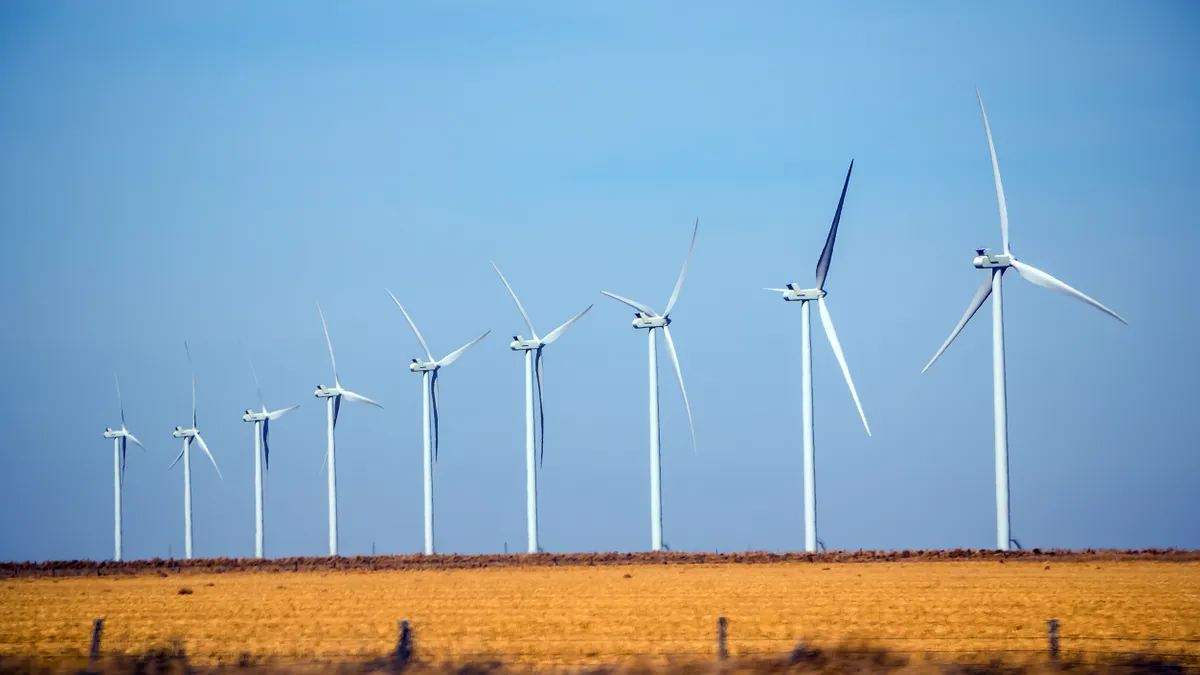Dive Brief:
- Texas lawmakers on Thursday questioned work by the state’s public utility commission to holistically redesign the state’s electricity market, fearing proposals under consideration by utility regulators “will not guarantee new dispatchable generation in a timely and cost-effective manner.”
- The Public Utility Commission of Texas in November discussed a new “performance credit mechanism” to incentivize generators to be available during times of high electricity demand. That proposal and others “should not be adopted ... without further consultation with the Legislature,” a group of nine state senators, led by the chair of the Senate Committee on Business and Commerce, said in a letter to the commission.
- The state’s electricity grid remains vulnerable to blackouts in extreme winter weather, grid operator Electric Reliability Council of Texas warned Tuesday. ERCOT and the PUCT have been working to bolster reliability since Winter Storm Uri caused widespread blackouts in 2021 and led to 246 deaths.
Dive Insight:
In the wake of Uri, the Texas Legislature passed Senate Bill 3 directing the PUCT to boost dispatchable generation and improve grid reliability. Regulators have been developing and implementing reforms for a year, but lawmakers fear their efforts may not be moving quickly enough to bring new generation online.
Along with the performance credits, the PUCT has also discussed a forward reliability market to ensure sufficient resources.
“There is significant concern the proposals being considered by the Commission ... not only fail to meet the directives clearly stated in SB3, but more importantly will not guarantee new dispatchable generation in a timely and cost-effective manner,” wrote Sen. Charles Schwertner, R, lead author of the letter.
There are also concerns that “implementing an administratively complex and novel concept could in fact deter new investments,” the letter said.
The senators requested the PUCT “define reliability goals for the ERCOT region” and “evaluate the impact of creating a new market-based ancillary or reliability service to meet this reliability standard.” And any proposals the commission considers should have clear performance requirements, lawmakers said, and “strong penalties for nonperformance.”
Stoic Energy President Doug Lewin, an energy analyst who closely watches the Texas market, said in an email that the senators’ letter is “essentially a vote of no confidence in the PUCT leadership.... The process is paused indefinitely, unless the PUC decides to ignore the will of the Senate which is highly unlikely.”
The PUCT says its decisions will ultimately go to the legislature for approval.
“As we’ve said since the beginning of this process, the PUCT will develop a reliability service as directed in Senate Bill 3,” PUCT Director of Communications Rich Parsons said in an email. “The PUCT published multiple options for consideration and eagerly awaits public comments on all options. Once the Commission holds a vote on a preferred reliability service, we will present it to the legislature next session.”
The commission has taken a range of actions to address generator performance failures that occurred during Uri, including comprehensive weatherization standards. The second phase of the market redesign, in the works now, looks at securing long-term reliability as the state’s power demand grows.
Despite market improvements and generator weatherization requirements, the grid’s reserve capacity is lower this season than last.
Heading into the coldest months, ERCOT’s seasonal assessment forecasted peak demand of 67,398 MW, with about 87,300 MW of resources available. But in extreme situations with higher demand, unexpected generator outages and low wind output, the grid could be short by 9,000 MW or more.
“Year to year we are developing more generation resources. The majority of those resources being added to the ERCOT grid tend to be renewable resources, like solar and wind,” ERCOT President and CEO Pablo Vegas said on Tuesday. Those resources do not perform as well in the winter, he said, explaining the reserve margin decline.
Experts say Texas should be looking for ways to control its energy consumption rather than build expensive power plants.
“Our research shows that demand response is the cheapest, cleanest & quickest to implement. I'm happy to brief your team on our findings,” Michael Webber, a professor at the University of Texas at Austin, tweeted in reply to Schwertner's letter.
“Even though it is within the PUCT's authority to do so, they haven't taken any action at all on energy efficiency, leaving us with an energy efficiency goal 80% below the average state,” Lewin said. “Policymakers also need to decide if high energy bills ... [are] a problem they'd like to solve. Building a lot of new gas power plants and requiring customers to pay for them will increase bills.”














